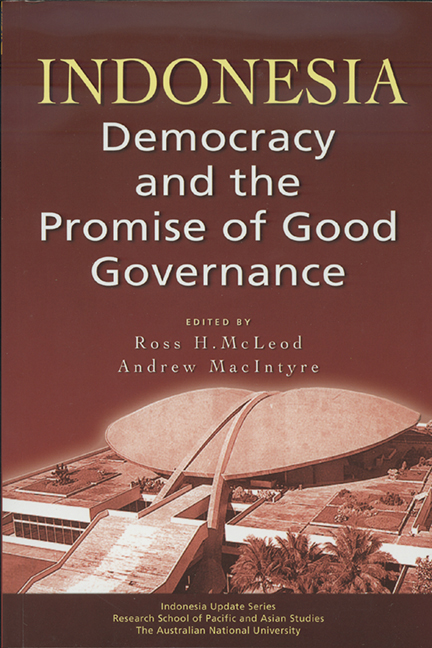Book contents
- Frontmatter
- Contents
- List of Tables and Figures
- List of Contributors
- Acknowledgments
- Glossary
- 1 Introduction
- PART I FORMING AND REFORMING THE ARCHITECTURE of GOVERNANCE
- 2 Indonesia's Constitutional Change Reviewed
- 3 Electoral and Political Party Reform
- 4 Tracing the Progress of Local Governments since Decentralisation
- PART II THE ROLES OF GOVERNMENT
- PART III THE INSTITUTIONS OF GOVERNMENT
- Index
- INDONESIA UPDATE SERIES
3 - Electoral and Political Party Reform
from PART I - FORMING AND REFORMING THE ARCHITECTURE of GOVERNANCE
Published online by Cambridge University Press: 21 October 2015
- Frontmatter
- Contents
- List of Tables and Figures
- List of Contributors
- Acknowledgments
- Glossary
- 1 Introduction
- PART I FORMING AND REFORMING THE ARCHITECTURE of GOVERNANCE
- 2 Indonesia's Constitutional Change Reviewed
- 3 Electoral and Political Party Reform
- 4 Tracing the Progress of Local Governments since Decentralisation
- PART II THE ROLES OF GOVERNMENT
- PART III THE INSTITUTIONS OF GOVERNMENT
- Index
- INDONESIA UPDATE SERIES
Summary
Political parties are a crucial part of democratic political systems. With Indonesia's return to democracy in 1999, operational controls on political parties and the ban on the establishment of new parties were lifted. Subsequent electoral reform was designed to reshape the party system by encouraging fewer, larger, parties. This chapter looks at this process from a comparative perspective, situating the Indonesian reforms in a broader Asian context. It also attempts to answer some basic questions about institutional reform. What are the trade-offs inherent in different electoral rules and party system configurations? Where does the Indonesian party system sit within the spectrum of party systems around the world? And how do trends in Indonesia compare with those elsewhere in the Asia-Pacific region?
DEMOCRATISATION AND POLITICAL REFORM
The number of East Asian regimes that can be considered to meet the basic Schumpeterian definition of democracy–governments chosen through open and competitive elections–has snowballed over the past 20 years (Schumpeter 1947: 269). While at the end of the Cold War only Japan could lay claim to being an ‘established’ East Asian democracy, the years since then have ushered in a new era of liberalisation and democratisation across the region (Lijphart 1999). Major transitions from authoritarian rule to democracy began with the popular uprising against the Marcos regime in the Philippines in 1986 and the negotiated transitions from autocratic governments in South Korea and Taiwan in 1987. They continued with the resumption of civilian rule in Thailand in 1992; the UN intervention in Cambodia in 1993; the fall of Indonesia's Soeharto regime in 1998; and the international rehabilitation of East Timor which culminated in 2001. While the 2006 coup in Thailand was a clear step backwards, today more East Asian governments are chosen through democratic processes than ever before.
- Type
- Chapter
- Information
- IndonesiaDemocracy and the Promise of Good Governance, pp. 41 - 54Publisher: ISEAS–Yusof Ishak InstitutePrint publication year: 2007



